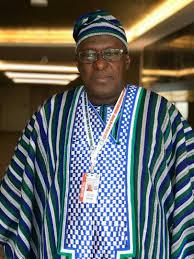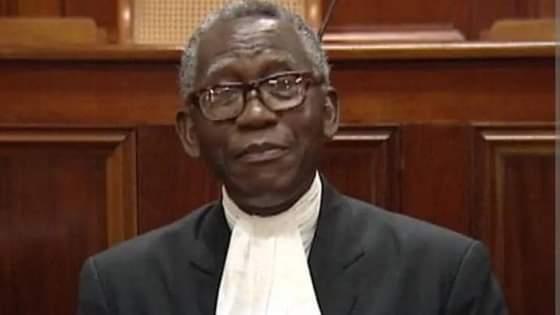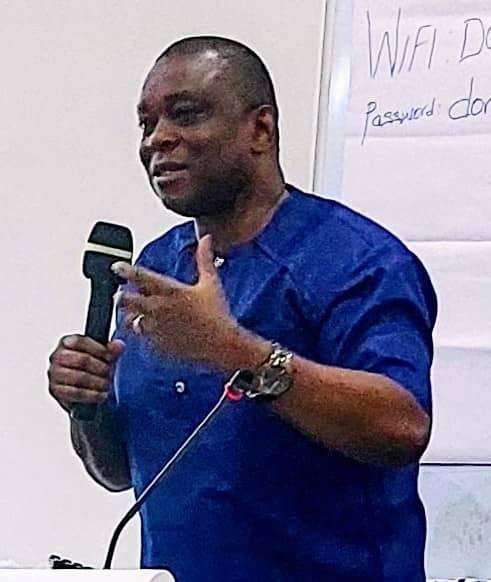In man’s land-Why it’s important to close the gender gap in disaster journalism
Catherine Katimu Kamara was a schoolgirl when she decided that she wanted to be an investigative journalist, to “go out there” and make a difference. In May 2014, when there was an Ebola outbreak in Kenema, she thought it was her chance to report from the ground and give a voice to the people. The problem was that nobody wanted to speak to her. (Illustration: Felix Rhodes)
“I went to the scene but they only allowed the people to speak to a male journalist,” says Kamara. “They told me they didn’t want to see me, they didn’t want to hear me, and they didn’t want to answer my questions. In our country, especially in Kenema, it is hard to be recognised as a female journalist.”
Catherine ended up being escorted away from the site that day, and the disappointing experiences have been stacking up ever since. “When you are told no constantly, you just wish you were a male in that particular moment,” says Catherine, who now works for Gola Agriculture Radio. “It makes me angry. I have to plead. I have to plead to get that story. When I am neglected and left out, it makes me feel bad.”
Like many other women journalists, Catherine feels discriminated against at the workplace. There have been times, she shares, when she’s been asked to use male reporters to conduct interviews for her stories. Sexism in the newsroom often means fewer opportunities to build capabilities for journalists like Catherine.
Earlier this year, a study conducted by Bournemouth University researchers in collaboration with the Sierra Leone Association of Journalists (SLAJ) found that there is a significant gender imbalance in disaster journalism training opportunities available to women journalists. Around 60 per cent of the women journalists surveyed in this study reported that they had received no disaster resilience training at all, which is 12 per cent more than the male journalists who came under this category. Similarly, while around 40 per cent of male journalists received disaster resilience training before or after the Ebola outbreak, only 32 per cent of women got the same advantage. This, of course, is a symptom of a wider problem.
Women journalists, whether or not they report on disasters, face discrimination across the world. A 2021 Reuter’s Institute survey spanning 240 news outlets in 12 markets across four continents found that only 22 per cent of the top editors were women. Women were underrepresented in general as well: only 40 per cent of the journalists in the markets sampled were women.
The gender gap is problematic in itself, but the underrepresentation of women in the media also affects the substance and quality of news. In 2020, the Global Media Monitoring Project (GMMP) released a report based on a survey of 116 countries, which revealed that even though women comprise half of the population, they make up only 25 per cent of the subjects and sources on screen, paper, or radio. What’s more, the underrepresentation of women working in media is linked with the propagation of gender stereotypes in the media and the underreporting of news that deals with gender equality and human rights.
There are similar trends in disaster coverage. Women make up only 27 per cent of the subjects of stories on disasters even though humanitarian crises disproportionately affect women and girls. This is not surprising since women are severely underrepresented in ‘hard news’, including disaster reportage.
The perspectives and insights of women reporters can add dimensions to disaster reporting that may be otherwise missing in Sierra Leone. Dr Cynthia Carter, a journalism academic in Cardiff University, UK, whose research has focused on gender in the media, says women’s experiences and knowledge have been historically devalued in society and also in journalism, to the detriment of both.
“Editors are in danger of missing out on the viewpoints of women journalists, which may be quite different to those of their male colleagues,” Dr Carter says. “I’m not suggesting women journalists, as a group, share one perspective. However, women’s experiences of doing journalism may provide a wider array of ways to talk about disasters that wouldn’t otherwise be included. The widest range of experiences, views, and approaches to covering such stories are good for journalism, good for women’s journalism careers, and good for society.”
Femi Jarret-Coker, the president of Women in the Media Sierra Leone (WIMSAL) and one of the two women editors in the country, also believes that the lack of female reporters means that some important stories in disasters go unheard. “It is ordinary women who are the most affected by disasters. Yet, we women cannot report our own stories,” she says. “Most disaster victims are women. Women and children are more likely to die than men. When women report issues about themselves, we will do a better job because men do have stereotypes about our gender and will not report on these issues in-depth.”
This could have a serious impact on real lives. Since enough women are not reporting on disasters, there might be less public awareness about the gendered vulnerabilities and impacts of these events. For instance, during the Ebola crisis, women were more at risk to contract the virus and die due to their role as caregivers who came into contact more frequently with bodily fluids. Insights like these could benefit the public at large. However, for women to report in disaster situations, investments in capacity-building are essential. “It’s crucial that women journalists have the tools they need to build resilience as they report on challenging events, where the potential for post-traumatic stress is most likely to occur,” Dr Carter says.
The news media industry in Sierra Leone has grown tremendously since the Civil War ended in 2002, according to the 2018 BBC Media Landscape Report. There is an array of radio stations across the country, and almost half the population tunes in daily for the news. Several new TV, print, and digital news outlets have also emerged in recent years. However, the industry is still largely male dominated.
“Currently, we have about two women who own newspapers. None for radio and television. There are 50 registered radio stations in Sierra Leone but only seven are managed by women,” says Millicent Kargbo, president of the Sierra Leone Association of Women in Journalism (SLAWIJ). She believes the current set-up “cripples” female journalists: “There is glaring inequality in the ownership of media institutions, in the leadership roles, and even in the top by-lines. Most hard or major news stories are given to male journalists, even when a woman journalist could have done an equally good story.”
The obstacles women disaster journalists face, however, are not limited to just resistant interviewees and unsupportive editors. In Sierra Leone, the persistence of traditional gender roles in society also mean that women face “marginalisation and discrimination” in education, employment, and politics. As a result of these cultural factors, women too may veer away from “masculine” roles and jobs that require interacting with the public and entering dangerous situations.
Marian Tina Conteh, who works with the BBC Media Action, says women are often seen as incapable. “Most of the time, we female journalists are classified as weaker vessels,” she says. Male colleagues, she adds, find it difficult to think of women’s duties extending beyond cleaning and cooking, and this affects the way women are treated in newsrooms. Eastina Taylor, who coordinates On Our Radar, a community reporting network, says being treated differently has affected her self-esteem. “It’s like you’re constantly fighting to be validated. If you’re a female journalist from any part of the world, you will understand what that means. This is a man’s space, and you’re fighting,” she says. She acknowledges, however, that gender-biased attitudes may seep into the consciousness of women too. “As a woman, society has already made you feel vulnerable, like you are the one who needs protecting, like you can’t do anything.”
Many women reporters in Sierra Leone must contend with not just the proverbial glass ceiling, but a glass box that prevents them from doing even the basic reporting and often denies them access to the same level of education and training that their male counterparts get. Being discouraged from reporting on hard news, as well as internalising sexist messages about their capabilities, makes it harder for women to make a name in their career, which perpetuates gender inequalities in the media.
The odds stack up against women who want to report on disasters for two basic reasons. The first is that it is seen as a male domain, by editors and the public alike. Assanatu Labelle Sillah, who works for Culture Radio, says she has been turned away by security guards and not been allowed to interview sources because of her gender. “It is frustrating!” she says. Fatmata Marian Sesay, who has worked at Radio Gbafth for the past 10 years says she has often been dissuaded from reporting on disasters. “I feel bad. I really feel bad. They can say they don’t think I should do it, or I shouldn’t go there, but they don’t need to discourage me to reach out to those [disaster-affected] people.” Generally, when women do get a chance to work on disaster stories, they are asked to put together statistics rather than being sent to the field.
Alusine Sesay, editor of Concord Times, has 10 reporters on his team, of which four are women. He acknowledges that he rarely sends them out to report on disasters but says this is for practical reasons rather than discrimination. “Most female journalists shy away from reporting on emergencies,” he says. “In most cases I assign male reporters when it comes to emergencies. It has nothing to do with discrimination, only that as an editor I decide [which] individual reporter will produce what fits into the threshold of the paper.”
The second issue is that when women are asked to report from the ground, they are not as well prepared as their male colleagues. Femi Jarret-Coker is deeply concerned about the gender disparity in disaster journalism training. “Disaster journalism demands a whole new approach. We lack the basic training, especially when it comes to observing the necessary measures and safety precautions,” she says. “We have few female journalists who normally report on disasters because they lack the capacity, they lack the training, and they lack the basic things when it comes to protecting themselves when reporting on these issues.”
Dr Carter sums up the bind this lack of training creates for women in disaster journalism: “The women journalists themselves may face the difficult choice of reporting about disasters without having had sufficient training on how to cope in such situations. If they do go in to report, they may face both short- and long-term traumas affecting them personally and professionally. Secondly, should they not cover such events, they may be disadvantaged in their career.”
While the pace of change in Sierra Leone’s newsrooms has been slow, the rise of women journalists’ collectives such as WIMSAL and SLAWIJ offer a glimmer of hope. The primary focus of these organisations is to contest gender stereotypes in journalism and to support women journalists in a variety of ways. SLAWIJ president Millicent Kargbo says one important initiative that the one-year-old organisation has launched is to provide more visibility to members via the Facebook change. Every week, the page celebrates the accomplishments of an “Eminent Lady” in journalism. “Men often say that women are not coming forward to be seen. For us, this is one way for employers to identify potential employees and give them a chance to work,” she says. The organisation is currently attempting to arrange fellowship programmes and other advancement opportunities for members. “Our intention is to engage media institutions continuously to create a level playing field. While we work on building the capacity of our membership, we will also lobby media owners to open up the space to female journalists.”
Over the last few years, Sierra Leone has also seen a small increase in the number of women editors, some of whom are working to bring about changes to their newsrooms. Mabinty Magdalene Kamara, editor at Politico, says she tries to ensure that men and women are treated equally, including when it comes to reporting on disasters. “Anyone can do it; if men can do it, why can’t you if you also have the professional skills? It all boils down to trust.”
Mabinty recognises that training is an essential component of making women come “up to the task”. She believes that some disaster resilience training programmes should be tailored specifically for women and not taught through a male lens. Ahmed Sahid Nasralla, President of SLAJ, agrees that this could be a viable option. “Our industry is male-dominated in terms of ownership, representation in leadership positions… even SLAJ itself,” Ahmed says. According to him, SLAJ is committed to working towards the goal of bringing more gender equality in the Sierra Leone media by working closely with women-led organisations like WIMSAL and expanding their reach and message. “We are also working to develop a gender policy for SLAJ, and encouraging media houses to also develop their own individual policies to ensure female journalists have equal opportunities and reporting tasks.”
Male allies such as Ahmed are essential in the journey ahead. Fortunately, the country does have a handful of media leaders who believe women should be given equal opportunities. Stanley Bangura, CEO of Hope FM, employs nine men and four women in the radio station. He recognises the need to battle gender inequality in the media. “It’s a big issue which we have been trying to contend with. It’s the big elephant in the room,” he says, adding that he does not hesitate to send female reporters out to cover big stories. “They are equal to the task.”
Copyediting and additional research: Asavari Singh.
NOTE: This article was first published on August 27, 2021 on www.tieuorja.org, which works to strengthen disaster communication in Sierra Leone.
By Charlotte Albutt and James Gray
Stay with Sierra Express Media, for your trusted place in news!
© 2021, https:. All rights reserved.






